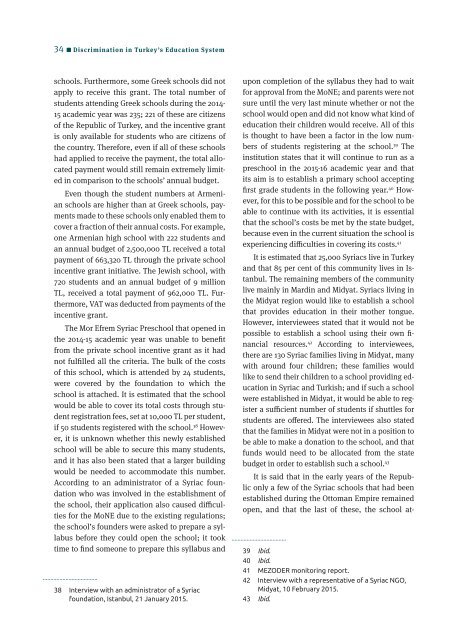Discrimination
EN-turkiye-egitim-sisteminde-ayirimcilik-24-10-2015
EN-turkiye-egitim-sisteminde-ayirimcilik-24-10-2015
You also want an ePaper? Increase the reach of your titles
YUMPU automatically turns print PDFs into web optimized ePapers that Google loves.
34 <strong>Discrimination</strong> in Turkey’s Education System<br />
schools. Furthermore, some Greek schools did not<br />
apply to receive this grant. The total number of<br />
students attending Greek schools during the 2014-<br />
15 academic year was 235; 221 of these are citizens<br />
of the Republic of Turkey, and the incentive grant<br />
is only available for students who are citizens of<br />
the country. Therefore, even if all of these schools<br />
had applied to receive the payment, the total allocated<br />
payment would still remain extremely limited<br />
in comparison to the schools’ annual budget.<br />
Even though the student numbers at Armenian<br />
schools are higher than at Greek schools, payments<br />
made to these schools only enabled them to<br />
cover a fraction of their annual costs. For example,<br />
one Armenian high school with 222 students and<br />
an annual budget of 2,500,000 TL received a total<br />
payment of 663,320 TL through the private school<br />
incentive grant initiative. The Jewish school, with<br />
720 students and an annual budget of 9 million<br />
TL, received a total payment of 962,000 TL. Furthermore,<br />
VAT was deducted from payments of the<br />
incentive grant.<br />
The Mor Efrem Syriac Preschool that opened in<br />
the 2014-15 academic year was unable to benefit<br />
from the private school incentive grant as it had<br />
not fulfilled all the criteria. The bulk of the costs<br />
of this school, which is attended by 24 students,<br />
were covered by the foundation to which the<br />
school is attached. It is estimated that the school<br />
would be able to cover its total costs through student<br />
registration fees, set at 10,000 TL per student,<br />
if 50 students registered with the school. 38 However,<br />
it is unknown whether this newly established<br />
school will be able to secure this many students,<br />
and it has also been stated that a larger building<br />
would be needed to accommodate this number.<br />
According to an administrator of a Syriac foundation<br />
who was involved in the establishment of<br />
the school, their application also caused difficulties<br />
for the MoNE due to the existing regulations;<br />
the school’s founders were asked to prepare a syllabus<br />
before they could open the school; it took<br />
time to find someone to prepare this syllabus and<br />
38 Interview with an administrator of a Syriac<br />
foundation, Istanbul, 21 January 2015.<br />
upon completion of the syllabus they had to wait<br />
for approval from the MoNE; and parents were not<br />
sure until the very last minute whether or not the<br />
school would open and did not know what kind of<br />
education their children would receive. All of this<br />
is thought to have been a factor in the low numbers<br />
of students registering at the school. 39 The<br />
institution states that it will continue to run as a<br />
preschool in the 2015-16 academic year and that<br />
its aim is to establish a primary school accepting<br />
first grade students in the following year. 40 However,<br />
for this to be possible and for the school to be<br />
able to continue with its activities, it is essential<br />
that the school’s costs be met by the state budget,<br />
because even in the current situation the school is<br />
experiencing difficulties in covering its costs. 41<br />
It is estimated that 25,000 Syriacs live in Turkey<br />
and that 85 per cent of this community lives in Istanbul.<br />
The remaining members of the community<br />
live mainly in Mardin and Midyat. Syriacs living in<br />
the Midyat region would like to establish a school<br />
that provides education in their mother tongue.<br />
However, interviewees stated that it would not be<br />
possible to establish a school using their own financial<br />
resources. 42 According to interviewees,<br />
there are 130 Syriac families living in Midyat, many<br />
with around four children; these families would<br />
like to send their children to a school providing education<br />
in Syriac and Turkish; and if such a school<br />
were established in Midyat, it would be able to register<br />
a sufficient number of students if shuttles for<br />
students are offered. The interviewees also stated<br />
that the families in Midyat were not in a position to<br />
be able to make a donation to the school, and that<br />
funds would need to be allocated from the state<br />
budget in order to establish such a school. 43<br />
It is said that in the early years of the Republic<br />
only a few of the Syriac schools that had been<br />
established during the Ottoman Empire remained<br />
open, and that the last of these, the school at-<br />
39 Ibid.<br />
40 Ibid.<br />
41 MEZODER monitoring report.<br />
42 Interview with a representative of a Syriac NGO,<br />
Midyat, 10 February 2015.<br />
43 Ibid.


